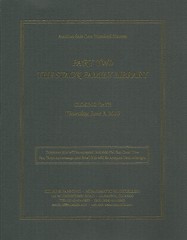
About UsThe Numismatic Bibliomania Society is a non-profit organization promoting numismatic literature. For more information please see our web site at coinbooks.org SubscriptionsThose wishing to become new E-Sylum subscribers (or wishing to Unsubscribe) can go to the following web page link MembershipThere is a membership application available on the web site Membership Application To join, print the application and return it with your check to the address printed on the application. Membership is only $15 to addresses in the U.S., $20 for First Class mail, and $25 elsewhere. For those without web access, write to: David M. Sundman, Secretary/TreasurerNumismatic Bibliomania
Society AsylumFor Asylum mailing address changes and other membership questions, contact David at this email address: dsundman@LittletonCoin.com SubmissionsTo submit items for publication in The E-Sylum, just Reply to this message, or write to the Editor at this address: whomren@coinlibrary.com
BUY THE BOOK BEFORE THE COINYou won't regret it! |
- WAYNE'S WORDS: THE E-SYLUM MAY 16, 2010
- KOLBE AUCTION SALE 112 RESULTS
- ESSAYS ON THE STACK FAMILY NUMISMATIC LIBRARY
- NEW BOOK: ASTRONOMICAL SYMBOLS ON ANCIENT AND MEDIEVAL COINS
- NEW BOOKS: THE LATEST TITLES FROM GEORGES DEPEYROT
- NEW BOOK: 2011 U.S. COIN DIGEST
- BOOK REVIEW: THE PATTERN COINAGE OF PETER GETZ BY GEORGE FULD
- BOOK REVIEW: HISTORIA DE LA CASA DE MONEDA DE GUATEMALA 1731-1776
- BOOK REVIEW: CURIOUS CURRENCY BY ROBERT D. LEONARD JR.
- BOOK REVIEW: WORLD PAPER MONEY ERRORS BY MORLAND FISCHER
- RED BOOK COVERAGE OF PHILIPPINE COINAGE
- AUGUSTUS SAINT-GAUDENS: THE RENAISSANCE OF AMERICAN COINAGE
- DR. FRANK A. LIMPERT PHOTO FOUND
- J. GOLDSBOROUGH BRUFF, NUMISMATIST, ARTIST, MEDAL DESIGNER
- FRANCIS SHALLUS, PHILADELPHIA ENGRAVER
- UNKNOWN COPPER COIN IDENTIFIED AS AMERICAN GAMING COUNTER
- ABOUT THAT GIANT CHINESE COIN...
- A PRETTY BOOK: HOMER R. STEPHENS' DALTON & HAMER
- MORE ON THE 2008 SPECIAL EDITION RED BOOK
- MORE ON HOWARD GIBBS, "THE DUDE ON THE CAMEL"
- QUICK QUIZ: ANOTHER MYSTERY NUMISMATIST
- NOTES FROM E-SYLUM READERS, MAY 16, 2010
- THE MERCATOR MEDAL OF DRAKE'S WORLD CIRCUMNAVIGATION
- QUERY: ANA PIONEER GEORGE W. RODE
- MORE ON THE BASHLOW CONFEDERATE CENT RETSRIKES
- THE EMERGENCY MONEY COLLECTOR, VOL. 2 NO. 3
- THE PICTURE OF DORIAN GRAY, NUMISMATIST
- A BLOG ABOUT BOOKS: EBOOKS AND PRINT ON DEMAND
- HARVEY STACK: ACTION NEEDED AGAINST COIN FAKES AND REPRODUCTIONS
- JACOBS PERKINS PRINTING AND ENGRAVING BUILDING OPENS
- WALL STREET JOURNAL: U.S. PLANNING COIN COMPOSITION CHANGE
- HOMETOWN OF U.S. GRANT LOBBIES TO KEEP HIM ON $50 BILL
- LARGEST BYZANTINE COIN HOARD UNCOVERED IN MACEDONIA
- ABU DHABI VENDING MACHINES TO DISPENSE GOLD
- THE SOUTH AFRICAN 1898 POND SINGLE 9
- NGC LAUNCHES NEW METALLURGIC ANALYSIS SERVICE
- FEATURED WEB SITE: HISTORIC MAP WORKS
WAYNE'S WORDS: THE E-SYLUM MAY 16, 2010

Among our new subscribers this week are Gary Patterson, courtesy of David Gladfelter, Joe Fitzpatrick, and Arianna D'Ottone. Welcome aboard! We now have 1,339 subscribers.
This week we open with results of Kolbe's 112th sale. Next, we have some interesting essays on the Stack Family numismatic library, and announcements and reviews of eight(!) new and recent books.
In topics raised earlier, we have more information on Frank Limpert, J. Goldsborough Bruff and Francis Shallus. In the news, we have articles on planned composition changes for U.S. coins and the opening of the Jacob Perkins Printing and Engraving building.
To learn about numismatics and astronomical symbols, Nemahaw half-chief Ke-ro-ich's peace medal, interest bearing paper money of the U.S., the U.S. "coins that might have been", the Picture of Dorian Gray, and some "great stuff on Bruff," read on. Have a great week, everyone!
Wayne Homren
Numismatic Bibliomania Society
KOLBE AUCTION SALE 112 RESULTS
 George Frederick Kolbe has joined forces with David F. Fanning and, on
May 13, 2010, the Kolbe firm concluded its final stand-along auction, featuring
a library of works containing three-dimensional illustrations of coins,
formed over several decades by Kirby W. Brown, and a nearly complete set of
W. Elliot Woodward auction sale catalogues from the Bob Vail library. Also
included was the property of over eighteen other consignors.
George Frederick Kolbe has joined forces with David F. Fanning and, on
May 13, 2010, the Kolbe firm concluded its final stand-along auction, featuring
a library of works containing three-dimensional illustrations of coins,
formed over several decades by Kirby W. Brown, and a nearly complete set of
W. Elliot Woodward auction sale catalogues from the Bob Vail library. Also
included was the property of over eighteen other consignors.
A few sale highlights include: the remarkable plate album to Schubert's 1857 Monnaies Russes which, after spirited bidding, brought $4,485 on a $2,000 estimate; one of the most heavily bid upon lots in the sale—several hundred photocopies of B. G. Johnson coin invoices to Virgil Brand and Colonel Green, among others—which ended up bringing $604; selling for $1,495 was an unusually nice example of the first edition of the RED BOOK, i.e., R. S. Yeoman's “Guide Book of United States Coins,” autographed by the author; a near new copy of Kraay and Hirmer's 1966 “Greek Coins,” sometimes considered “the world's most sought after numismatic book,” sold for $834; W. Elliot Woodward sale catalogues mostly sold for well over estimate, perhaps highlighted by the notoriously rare Sale 92, which realized $1,955 on a $1,250 estimate. All results mentioned here include the 15% buyer premium.
The newly formed firm of Kolbe & Fanning have collaborated to produce the firm's first joint catalogue, comprising the second part of the library formed by the Stack family. The sale closes on June 3, 2010.
In September, Kolbe & Fanning will feature two notable auction sales of rare and out of print numismatic literature. The first, on September 12, 2010, will feature the select library of early printed numismatic works formed by noted Scandinavian numismatist, Anders Frösell. The sale will coincide with the auction of Frösell's coin collection in Stockholm.
Kolbe & Fanning are also pleased to report that the outstanding library of wellknown American coin dealer, numismatic photographer and, auctioneer Robert J. Myers, will be sold on September 20, 2010. Myers's comprehensive library spans the entire range of ancient numismatics, featuring a multitude of rare original editions, and is also rich in key works on ancient art as well as a selection of classic works on historical medals.
Copies of the two September sales or the June 3, 2010 Stack Family Library catalogue may be reserved by sending $10.00 to KOLBE & FANNING LLC, NUMISMATIC BOOKSELLERS, 141 W JOHNSTOWN ROAD, GAHANNA OH 43230-2700; Telephone: (614) 414-0855; Fax: (614) 414-0860; Email: df@numislit.com or GFK@ numislit.com. The catalogues will also be accessible free of charge several weeks before the sale at the firm's web site: www.numislit.com.
Kolbe & Fanning also plan to issued a fixed price list in early summer, a mail auction sale in November, and will conduct a major public auction sale of rare and desirable numismatic works at the Waldorf Astoria Hotel on January 8, 2011 in conjunction with the New York International Numismatic Convention. Important consignments for this sale are currently being accepted. Kolbe & Fanning Numismatic Booksellers, 141 W. Johnstown Rd., Gahanna, OH 43230 (614) 414-0855, fax (614) 414-0860, gfk@numislit.com, df@numislit.com www.numislit.com
ESSAYS ON THE STACK FAMILY NUMISMATIC LIBRARY
From David Tripp:
I can't believe it's gone. The books have been emptied off the shelves, and the Stack family has left the building. It's impossible to believe. I was born and raised in Manhattan, which means, if you are of a certain age (and I am), and had an interest in coins, you knew of Stack's: pure and simple. If you asked a cabby to take you to Stack's by name, he would.
My mom took me to Stack's when I was a kid, only once, and all I remember was the wonderfully warm, clubby atmosphere, and the books. While I looked round goggle-eyed my mom quietly bought a coin from Norman Stack, which was given to me on my next birthday. I still have it.
And I still remember those books. I come from a family of readers and I count books among my best of friends. My father bought me my first ancient coin only after he made me buy a book to explain what I was looking at—it changed my life. Coins may be a portal to the past, but books are the keys to open that door.
It was not until 1973 that I really got to know Stack's and the family. They were, I was told, the evil empire. I was the new coin department at Sotheby's and was expected to get property, have sales, and to be competitive. Talk about a tough row to hoe!
One of the first things I did, aged 21, and in over my head, was head on down to 57th street, and introduce myself. I was ushered into the back room, where Norman Stack chatted with me (I have no idea where Harvey was). He was courtly, to the point, probed me as to what I was about, and what I knew…all the while sizing me up as a potential competitor (and clearly he lost no sleep that night).
I sat in that sanctum sanctorum listening attentively to Norman, all the while covetously eyeing the books that sat comfortably in their domain behind those glazed doors. I was utterly stunned when he said to me, as I was about to leave, that if I ever needed to avail myself of their library to check something, I need but ask. These were my enemies?
From John L. Sanderson:
After the collecting bug hit me full force, I started dealing to the trade. In other words I was a wholesale only dealer, but I specialized in the more esoteric end of the U. S. market to the exclusion of post-1792 coinage, and post-1865 paper money. It seemed to me that there was a gap that I could fill in the dealing community if I only had something special to offer.
Being only in my 20s, I knew it wasn't going to be my decades of experience, so I had to come up with something. I noticed that in my travels from show to show, and shop to shop up and down the eastern seaboard that many dealers had the “esoteric” material in their shops and booths, and did not know what it was, much less its relative value.
I also found that many of the same dealers would sell their books to any reasonable bid for quick cash. Here, as I finally managed to fire off a neuron or two, would be my niche. I would read numismatic books. Not just thumb through them. I would read them cover to cover.
As I got into it I realized that the dullest, most mind-numbing book was often best because I was picking up what the average full-time dealer did not have the time nor inclination to do, which was to actually read numismatic books. It didn't take long for me to be able to hold my own in the thin market of “out of the way” numismatics.
NEW BOOK: ASTRONOMICAL SYMBOLS ON ANCIENT AND MEDIEVAL COINS
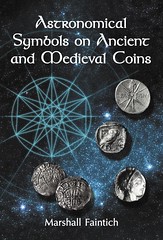 Astronomical Symbols on Ancient and Medieval Coins
Astronomical Symbols on Ancient and Medieval Coins
Marshall Faintich
232 pages $55 hardcover (7 × 10)
566 illustrations, maps, appendices, bibliography, index
ISBN 978-0-7864-3178-6 2008
The coins of ancient and medieval Europe provide unique insights into the economic and political history of their period. In a time when few members of the population could read or write, the symbols depicted on coins offered a medium for communication, propaganda, and historical archiving.
This work hypothesizes that astronomical symbols on ancient and medieval coins were often used as a way to record actual celestial events. The author provides more than 550 figures and line drawings of coins, maps, and astronomical events to illustrate this hypothesis. In addition, several appendices evaluate the historical accuracy of ancient and medieval coinage and offer additional examples not included in the main volume.
Marshall Faintich has a Ph.D. in astronomy, is a past national director of the American Cartographic Association, and has been a numismatist for more than 50 years. He lives in Central, Virginia.
McFarland & Company, Inc., Publishers
Box 611
Jefferson, North Carolina 28640
336-246-4460
Orders 800-253-2187
FAX 336-246-4403
www.mcfarlandpub.com
In Europe, North Africa and the Middle East, order from: The Eurospan Group, www.eurospangroup.com
In Australia and New Zealand, order from: DA Information Services, www.dadirect.com
In India, order from: Viva Books, www.vivagroupindia.net
To order, see: Astronomical Symbols on Ancient and Medieval Coins (www.mcfarlandpub.com/book-2.php?id=978-0-7864-3178-6)
NEW BOOKS: THE LATEST TITLES FROM GEORGES DEPEYROT
Two new publications are now available (M 106-107) Two other volumes (M 108-109) will be available before the summer.
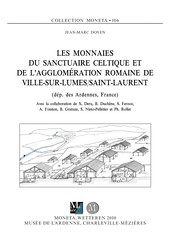
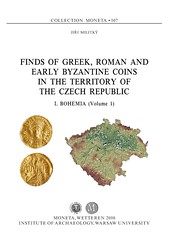
M106, J.-M. Doyen, Les monnaies du sanctuaire celtique et de l'agglomération romaine de Ville-sur-Lumes / Saint-Laurent (dép. des Ardennes, France), 2010, 442 pages, ISBN 978-90-77297-74-2 € 75
M107, J. Militký, Finds of Greek, Roman and Early Byzantine coins in the territory of the Czech Republic, I. Bohemia (Volume 1), 2010, 290 pages ISBN 978-90-77297-75-9 € 55
M108, J. Militký, Finds of Greek, Roman and Early Byzantine coins in the territory of the Czech Republic, I. Bohemia (Volume 2), 2010, 196 pages € 55
M109, J. Militký, Finds of Greek, Roman and Early Byzantine coins in the territory of the Czech Republic, I. Bohemia (Volume 3), 2010, 206 pages € 55
Information and order on www.moneta.be .
NEW BOOK: 2011 U.S. COIN DIGEST
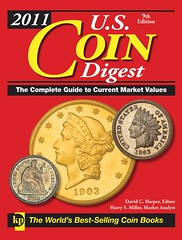 The new edition of the ultimate U.S. coin book, U.S. Coin Digest is now available from Krause Publications.
The new edition of the ultimate U.S. coin book, U.S. Coin Digest is now available from Krause Publications.
Now in its ninth edition, this full color coin guide is packed with comprehensive information that serves the needs of seasoned collectors, as well as the person who inherited a collection or has a few coins they are wondering about. Listings include circulating and non-circulating coins from early colonial times to modern issues, including the new coins of the presidential dollar series.
Each coin is introduced with details about the designer, its diameter, weight and composition and key notes about strikes or varieties, and it is followed by line listings with mintage and price for each issue by year. With current pricing in up to11 grades of condition, the accuracy of this U.S. coin guide is unmatched.
The 288-page book also contains 1,600 color photos, and is produced in hard cover with concealed wired binding. This allows for users to lay the book flat for hands-free research while inspecting coins. The obverse and reverse color photos also give readers an added edge in properly identifying coins.
U.S. Coin Digest 2011 is edited by David C. Harper, the editor of Numismatic News, who has more than 45 years of experience in the hobby, and Harry Miller, a prominent coin dealer and founder of Miller's Mint.
For more information visit www.shopnumismaster.com/product/2011-us-coin-digest/new
BOOK REVIEW: THE PATTERN COINAGE OF PETER GETZ BY GEORGE FULD
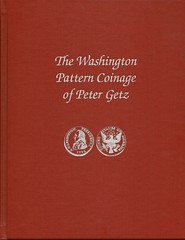 "The Washington Pattern Coinage of Peter Getz" by George J. Fuld was published in 2009 by George Kolbe and Alan Meghrig. It's a marvelous compendium of information on these important components of the fledgling United States coinage.
"The Washington Pattern Coinage of Peter Getz" by George J. Fuld was published in 2009 by George Kolbe and Alan Meghrig. It's a marvelous compendium of information on these important components of the fledgling United States coinage.
The first thing most E-Sylum readers would notice about this book, I think, is the roster of names in the Acknowledgements section. Many are regular readers and contributors here, too, including Alan V. Weinberg, Q. David Bowers, Richard Doty, Erik Goldstein, John Adams, Julian Leidman, Joseph Lasser, Joe Levine, Karl Moulton, Kerry Wetterstrom and Anne Bentley. Thanks and congratulations are in order to all involved, especially author Fuld and publishers Kolbe and Meghrig for pulling together the information and photos from widely scattered sources.
The genesis of the book was a preliminary research study by Jack Collins written shortly before his death in 1995. His "Condition Census of Getz 1792 Coinage" provided the stating point, but appearances on the numismatic market in 2004-2006 of pieces tucked long ago into collections provided a new focus and awareness of Getz patterns.
From the Introduction, page v:
Don Taxay notes that sometime before December 1791, [Superintendent of Finance Robert] Morris had already engaged artists to prepare patterns for a half dollar and a cent... The devices were engraved by twenty-three-year-old Peter Getz, a self-taught silver and goldsmith from Lancaster, who was described as "remarkable for the extraordinary accuracy, elegance and beauty of the workmanship he executed." ... Robert "Bob" Birch supervised Getz's work on the dies and sank the punches for the date and legends.
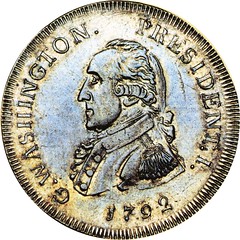
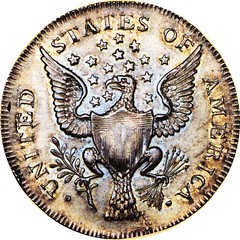
Baker 24, #1 – Davis-Ford-Boyd specimen
(c) 2004 by Stack's
The pieces all feature a portrait of George Washington, as the enabling legislation introduced by Morris called for "an impression or representation of the head of the President of the United States..." Washington however, later killed the idea, and that clause was stricken from the bill before it was signed into law on April 2, 1792.
These were "the coins that might have been." Without Washington's strong objection, the new government of the United States would have initiated a coinage tradition perhaps uncomfortably similar to that of the country it had just fought a war to be free of. Just like the King, the President's image, name, and "the succession of the Presidency numerically" would grace the nation's coinage, paving the way for not only "G. Washington, President I", but "A. Lincoln, President XVI" and perhaps even "B. Obama, President XLIV"
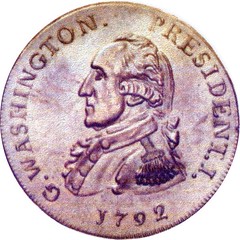

Baker 25, #3 – Norweb specimen
(c) 2006 by Stack's
The publication details 22 different silver 1792 Getz patterns, 55 different copper 1792 Getz "cents" and 20 different 1797 Getz Masonic medals. Full backgrounds are supplied on each coin and they are mostly illustrated in color. Also included is full discussion of the unique Getz Large Eagle "pattern", Baker 23 is given as well as the complete story about the Washington ladle.
The 147-page book includes a short chapter on Fakes & Fantasies and is available in two formats: spiral and hardbound (cloth). My copy of the hardbound is illustrated here.
Copies of the Spiral-Bound Edition are $100.00 and the Cloth-Bound Edition is $135.00 per copy postpaid in the U. S., plus 8.75% sales tax for California residents. Copies of the books may be ordered from George F. Kolbe, P. O. Drawer 3100, Crestline, CA 92325-3100. After December 31, 2010, orders for the book will no longer be accepted.
To read the earlier E-Sylum article, see: NEW BOOK: THE PATTERN COINAGE OF PETER GETZ BY GEORGE FULD (www.coinbooks.org/esylum_v12n27a02.html)
BOOK REVIEW: HISTORIA DE LA CASA DE MONEDA DE GUATEMALA 1731-1776
Carlos Jara writes:
I published my book on the Guatemala colonial Mint, titled "Historia de la Casa de Moneda de Guatemala 1731-1776" in a print run of 500 copies. Jorge Proctor (the renowned author of "The Forgotten Mint of Colonial Panama") was kind enough to send me this review, for publication in The E-Sylum.
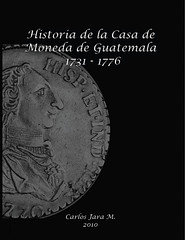 Carlos Jara does it again - this time with the mint of Guatemala!
Carlos Jara does it again - this time with the mint of Guatemala!
Guatemala, whose mint was founded in 1731, has had a long history in the field of Spanish Colonial numismatics. They once were thought to be the first mint established in Central America - a title now bestowed on Panama. But, Guatemala, nonetheless, has never lost its allure. In fact, the mint of Guatemala would become the most successful Spanish Colonial mint in Central America and the first to produce gold coins in this region.
With such a historic past, it is hard to believe that only a few researchers, such as the great José Toribio Medina and Kurt Prober, ever occupied themselves with this mint. So its history, and mainly its early history, has remained mostly in obscurity for over 250 years.
But now, at last, a new breed of scholar, in the form of Carlos Jara Carlos Jara, has volunteered his time and efforts to tackle a task that might have seemed overwhelming for even the most experienced researcher, but not for Mr. Jara. Within the 449 pages of this new book, you will be able to follow an easy to read narrative that is so complete as to not leave anything to question or the imagination of the reader.
With in-depth details and historical analysis, profusely illustrated with images from important coin collections and century old coin catalogs, along with a documentary section that provides a mini personal archive of this mint, the author makes this book a must for numismatists, historians, researchers and the general public alike.
The book: “Historia de la Casa de Moneda de Guatemala 1731 – 1776” is bound to become an instant classic in the field of Spanish Colonial Numismatics.
Now the sale info: The book consists of two parts: a main book written in Spanish of 449 pages, hardbound on glossy paper, with the gold coins' catalog section in colour. Added to it is a 50 pages softbound booklet written in English, on glossy paper (in black and white), which is a summary of the main book.
The price is $115 for both, plus postage. The booklet cannot be sold alone. Shipment will start in early June, and they will be sent from Miami. Interested parties can contact clejara@yahoo.com or Alan Luedeking at alan@ludeca.com
BOOK REVIEW: CURIOUS CURRENCY BY ROBERT D. LEONARD JR.
 Curious Currency: The Story of Money from the Stone Age to the Internet Age by Robert D. Leonard, Jr., Whitman Publishing, 2010
Curious Currency: The Story of Money from the Stone Age to the Internet Age by Robert D. Leonard, Jr., Whitman Publishing, 2010
Friedrich A. Hayek called Milton Friedman's theory of "monetism" a Keynesian theory because, in Hayek's view, there are more forms of money than central bankers can tally. This book proves that. To dismiss "primitive" money as irrelevant to the "modern" world is to miss the fact that many of these moneys -- coweries, manillas, spearheads -- were current in the 20th century. Others -- gold, silver, cows, wheat -- are major markets today. Still others -- coins, banknotes, credit cards -- are so familiar that we overlook their place in the matrix of money.
In each case, Leonard gives reliable information about the actual use of these objects from original sources. Leonard's conceptual organization of this complex subject is masterful. For the cover price of $12.95, this lavishly illustrated 150-page overview is replete with 481 citations. The index is truly helpful.
We all have a lot of books. For me, this one goes on the shelf with Breen, Taxay, and Newman, Sayles and Sear, and the Krause Standard Catalogs. In fact, it goes to the start.
To view the YouTube video, see: Hayek on Milton Friedman and Monetary Policy (www.youtube.com/watch?v=fXqc-yyoVKg)
BOOK REVIEW: WORLD PAPER MONEY ERRORS BY MORLAND FISCHER
Regarding last week's new book announcement, Joe Boling writes:
It would have been handy if Zyrus Press had mentioned the PRICE of Fischer's new book on world error notes. I found it on Amazon (not in stock - will ship when available) for $34.95.
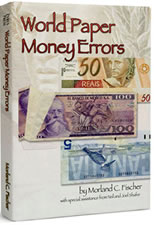 My copy of the World Paper Money Errors book by Morland C. Fischer arrived this week, and it's a visual treat. There is precious little text in the book, but for anyone at least somewhat familiar with U.S. paper money errors, more text is unnecessary. Methods of producing banknotes are similar throughout the world, and the types of errors are understandably similar.
My copy of the World Paper Money Errors book by Morland C. Fischer arrived this week, and it's a visual treat. There is precious little text in the book, but for anyone at least somewhat familiar with U.S. paper money errors, more text is unnecessary. Methods of producing banknotes are similar throughout the world, and the types of errors are understandably similar.
Fischer's book organizes the error notes into several standard categories, including shifted overprint errors, inverted faces/backs, inverted or missing overprints, mismatched serial numbers, etc.
One feature is really like is the inclusion of images of normal notes alongside the error notes - this makes it very easy for those of us not already familiar with the notes to clearly see the problem. I also commend the author and publisher for including images of BOTH sides of the error note, even though often only one side exhibits the error. Again, this is a great help for those unfamiliar with the banknotes of a given country.
Another feature I found useful was the section illustrating each major type of error with both a U.S. banknote and one from another country. This focus on U.S. readers and collectors is nice for those of us in the U.S., although I wonder if readers from other countries will care for it.
Similarly, I wonder if the book's "FEN Scale" (Foreign Error Note categories) is appropriately named. Germany banknotes aren't foreign to a German, but U.S. banknotes are. The book's title is appropriately less provincial.
I'm not qualified to review the book's price estimates, but I think most readers will find them quite useful. All in all this seems to be an extremely useful guide to the field. Illustrated in color throughout, the book is a visual delight - even a casual reader should enjoy the wonderful range and beauty of the world banknotes pictured within (typically three notes per page).
To read the earlier E-Sylum article, see: NEW BOOK: WORLD PAPER MONEY ERRORS BY MORLAND FISCHER (www.coinbooks.org/esylum_v13n19a02.html)
THE BOOK BAZARRE
- We have the lowest consignment fees in the industry.
- We have a 60% minimum acceptable bid, to protect your interests.
- We have three auctions a year, scheduled, so you know when your items will be offered.
- All our auction material is consigned; we do not own lots in our auctions.
- We do not charge for our catalogs, so that maximum exposure occurs.
- We have the fastest consignment payoffs in the industry.
- We do not issue fixed prices lists, as auctions are our only business!
- We do not charge for our catalogs.
- We have the lowest per lot packing fees of any major Numismatic Literature dealer.
- We ship lots in the shortest time frame after a sale closes.
- We reduce all bids when competition permits.
- We work with all bidders to make your auction experience the best it can be!
RED BOOK COVERAGE OF PHILIPPINE COINAGE
A Red Book reader wrote in this week with a question about the section on Philippines coinage. He was disappointed that in recent years we've condensed that section from nine pages to five. This might be something that E-Sylum readers have noticed, as well.
I appreciate the correspondent's enthusiasm for the coins of the Philippines. As he noted, the coins struck by the U.S. Mint for the Philippines, under U.S. sovereignty, are an important part of our nation's numismatic history. Not only that, but they're official coins of the United States, struck on North American soil as well as in Manila, and legally exchangeable for U.S. dollars.
This is why we list the Philippines coins in the Red Book. Due to space constraints, we've had to condense the Philippines section, as noted. We did this by doubling up the layout of some charts, and showing only representative photos of the major coinage designs, rather than photos of every coin.
We've kept all of the mintage information and technical specifications for each denomination, as well as valuations. If space allows in future editions of the Red Book, we might be able to expand the Philippines section to include more photographs. In the meantime, I hope our readers agree that we've managed to make the best use of a finite number of pages by including as many photos as possible and all of the technical information available.
For E-Sylum readers interested in the rich history of the U.S. Mint in Manila, I highly recommend David W. Lange's History of the United States Mint and Its Coinage, which has an entire section on the subject. Richard Doty's America's Money, America's Story also includes information on our Filipino coinage. Both of these are Whitman books, and members of the American Numismatic Association can borrow them for free from the Dwight N. Manley Numismatic Library.
AUGUSTUS SAINT-GAUDENS: THE RENAISSANCE OF AMERICAN COINAGE
The educational event “Augustus Saint-Gaudens: The Renaissance of American Coinage” is being held August 15-18 at the Saint-Gaudens National Historic Site, Cornish, New Hampshire. The seminar is the American Numismatic Association's inaugural “Destination Education” program, and offers a once-in-a-lifetime opportunity to study the life and work of Saint-Gaudens in the beautiful New Hampshire setting where he created his work and made his home.

No artist embodied the optimism of the American Renaissance movement more than sculptor and numismatic designer Augustus Saint-Gaudens (1848-1907). Students will spend three nights at the historic Juniper Hill Inn and attend four 3-hour sessions scheduled over two days to study his work and influence on American art and coinage.
“Augustus Saint-Gaudens: The Renaissance of American Coinage” is being held in conjunction with the American Numismatic Association's 2010 World's Fair of Money® in Boston. The cost is $1,595 per person and $2,390 per couple (one queen bed). The price is all-inclusive: tuition, gourmet meals, lodging and transportation are included.
This event is for members of the ANA or the American Numismatic Society. To register or for more information, call 719-482-9850 or visit www.worldsfairofmoney.com.
Some of the world's top Saint-Gaudens scholars will be featured:
Dr. Henry J. Duffy, Curator, Saint-Gaudens National Historic Site
A Tour and Overview of the Saint-Gaudens National Historic Site and Museum
Dr. Duffy will lead a museum tour of the site and present a lecture covering the historic Saint-Gaudens site, the artist's life and his importance to American art history. Over 100 of Saint-Gaudens' works can be seen in the galleries.
Dr. Ute Wartenberg Kagan, Executive Director, American Numismatic Society
Augustus Saint-Gaudens and his Influence on Medallic Art in America
Although Saint-Gaudens is best known for his sculptures and coin designs, he worked extensively on medals and plaques. Dr. Wartenberg Kagan will examine Saint-Gaudens' artistic influences, primarily from 19th century French and Italian Renaissance medals.
Roger W. Burdette, author, The Renaissance of American Coinage
Saint-Gaudens and America's Coinage
By the late nineteenth century the Treasury Department and Bureau of the Mint were in agreement: it was time to change the designs on America's coins. Mr. Burdette will discuss how President Theodore Roosevelt's vision for U.S. coins and faith in the skills of Saint-Gaudens began a Renaissance of American Coinage.
John Mercanti, Chief Engraver, United States Mint
Engraving Artistry & Techniques
Mr. Mercanti will lead a discussion about numismatic engraving techniques and artistry, and how they have changed since Saint-Gaudens' time. He will also focus on the development of digital data that enabled the U.S. Mint to generate work dies that produced the 2009 version of the 22k Saint-Gaudens ultra high relief coin.
The Juniper Hill Inn is an historic Vermont bed and breakfast located in the town of Windsor and is the largest Colonial revival mansion in New England. It is listed on the National Register of Historic Places, and its hilltop setting provides spectacular views of Ascutney Mountain and Lake Runnemede. Presidents Theodore Roosevelt, Woodrow Wilson, Calvin Coolidge and Dwight Eisenhower stayed at this beautiful inn. The dining room offers the opportunity to connect over an elegant menu with comfortable country service, and guest rooms complement the rest of the property in both elegance and privacy.
The American Numismatic Association is a Congressionally chartered nonprofit educational organization dedicated to encouraging people to study and collect money and related items. The ANA helps its 32,000 members and the public discover and explore the world of money through its vast array of education and outreach programs, as well as its museum, library, publications, conventions and seminars. For more information, call 719-632-2646 or visit www.money.org .
Is it, shall we say, pricey? Indeed. This is no Priceline reservation, but for four days and three nights of all-inclusive numismatic nirvana, it's not so bad. I hope some of our readers attend. -Editor
DR. FRANK A. LIMPERT PHOTO FOUND
Last week Benny Bolin asked for pictures of Lester Merkin, S.H. Chapman and Dr. Limpert. I located the first two, but was stumped on Limpert. I should have looked harder. As my Mom always used to say, "If it had been a snake it woulda bit ya!" Walt Wiegand writes:
If you will check "Conclusion", page 99 of Limpert's book, you will find an image that I assume from the context is that of the author.
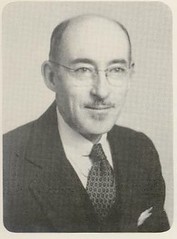
To read the earlier E-Sylum article, see: QUERY: MERKIN, CHAPMAN AND LIMPERT PHOTOS SOUGHT (www.coinbooks.org/esylum_v13n19a15.html)
J. GOLDSBOROUGH BRUFF, NUMISMATIST, ARTIST, MEDAL DESIGNER
First to respond (at midnight Sunday!) was none other than Q. David Bowers himself, whose book "American Numismatic Association Centennial History" inspired my query. He forwarded text on Bruff from his book "A California Gold Rush history: Featuring the Treasure from the S.S. Central America". Here's an excerpt.
J. Goldsborough Bruff, captain of the Washington City & California Mining Association, created one of the more elaborate journals of any Forty-Niner. In fact, he created multiple diaries and sketchbooks, sometimes overlapping. Bruff was a numismatist, as reflected by the contents of his estate, which included a copy of Montroville W. Dickeson's impressive American Numismatical Manual, published in 1859. As to whether he followed the hobby in the days of '49 the present writer does not know. However, he is the only Forty-Niner known to us who described an Indian peace medal being worn by its recipient.
April 30, 1849. Monday. Ke-ro-ich, a Nemahaw half-chief, came into camp. He wore a silver medallion with bust of president Van Buren on it. A drunken emigrant several days afterwards, jerked it off his neck, and kept it the greater part of a day, but had to restore it on the old chief kicking up a rumpus—threatening to look out for the emigrant when he should cross the river and pass through their country.
David Gladfelter writes:
Bruff (1804-1889) was a “topographical draftsman and amateur artist” who worked for a federal engineering agency. During the gold rush he went to California, where he organized the California Mining Association. He kept an illustrated journal, which was published in 1944.
From 1876 until his death, he worked for the Office of the Supervising Architect in the Treasury Department. There is more in Groce and Wallace, "The New-York Historical Society's Dictionary of Artists in America 1564-1860". This book answers many basic questions about U.S. die sinkers and engravers in the period before 1860.
The late Bob Lindesmith recommended this source book to me many years ago, when we were writing articles about token and medal engravers and die sinkers. I have used it in numismatic research many times. You should be able to find it in most public or college libraries.
Dick Johnson writes:
Cornelius Vermeule must have seen the same document Dave Bowers mentioned in his A.N.A. Centennial History. Vermeule mentions Bruff on page 51 in his Numismatic Art in America.
Joseph Goldsborough Bruff was one of the most difficult artists on which to obtain any sustentative biographical data. Even Joseph Florimond Loubat, with the vast resources he must have had at his disposal to compile his magnificent 2-volume masterpiece, The Medallic History of the United States, 1776-1876, had only 3 lines on Bruff! Loubat cast a very wide net. He did not capture much on Bruff.
Bruff designed only one medal -- the 1868 Cyrus West Field Medallion, Julian PE-10, Loubat 77 (also Storer, Massachusetts, 1924). There was one of these medals in the David Dreyfus auction April 12, 1986, by Bowers & Merena and Presidential Coin & Antique. I sold one in a CAL auction, and Joe Levine has sold at least two more in his auction sales (I have not recorded all his auction sales in my databank yet, there may be more).
Below is a part of the entry on Bruff from my databank on American Coin and Medal Artists. Incidentally, I have made the decision to place this on the Internet for all to access instead of publishing this in a hardback book. I hope to accomplish this in 2010.
BRUFF, Joseph Goldsborough (1804-1889) American amateur artist, topographical draftsman; as employee of Treasury Department he designed one medal.
Born Washington, DC, 2 October 1804.
Vermeule stated Bruff prepared sketches for an eagle intended for a U.S. coin; the design pleased chief engraver James Longacre who preserved the sketches and may have influenced his design of the 1849 U.S. double eagle but he is not credited for this.
Huntington Library, San Marino, California, has three paintings by this artist, all western U.S. scenes.
Died Washington, DC, 14 April 1889.
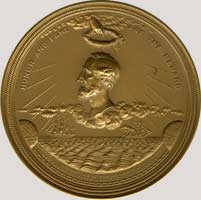
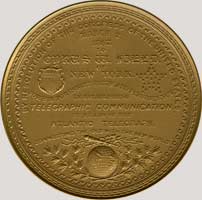
The Field medal is singular in nature because it was awarded twice, something a little out of the ordinary for Congressional medals. Perhaps the intrepid Field, for all the troubles he had gone through from the elements and business rivals, deserved more than one medal.
After the Congressional resolution of March 2, 1867, matters were to move rather quickly. Joseph Goldsborough Bruff of the Treasury Department, who prepared the original design, finished it by late July and within a few days it was on the way to the mint. (He was Supervising Architect of the Treasury Department at that time.)
Although Bruff produced a fairly detailed drawing for his design, William Barber, then an assistant engraver, asked for a sitting with Field in New York so that the likeness might be as perfect as possible. In September, 1867, Barber went to New York and carefully sketched Field. Barber returned quickly to the mint and began work on the proper models.
For more information, see: atlantic-cable.com/Field/medal.htm
Michael Paradis found a wonderful lithograph print by Bruff in a February 15, 2006 auction by Dorothy Sloan—Rare Books:
“Bruff, an accomplished artist, organized a company which traveled overland to the gold region in 1849-50. The letter refers to their trials and tribulations, as well as to the projected publication of Bruff 's notes and drawings on his arduous trip.”
This inimitable lithograph is entertaining, utterly captivating, and highly clever. Many meanings are indicated by charming phonic pictures rather than spelled words, such as the dateline for Washington City, with a miniature view of the city of Washington, D.C., the word “of ”, and a bust portrait of George Washington. Bruff 's lively art work and wonderful sense of humor shine at their best in his rebus letter. There is such an immediacy and fluidity of line in the letter it is difficult to believe it was engraved on the stone in reverse.

For more information, see: Bruff's Rare Rebus Letter (www.dsloan.com/Auctions/A16/lot_016.html)
He was born on October 2, 1804 in Washington, D. C., son of Thomas Bruff, a physician. He went to West Point from 1820-1822 studying as a topographical engineer. He was dismissed from West Point in 1822 supposedly because of his involvement in a duel. He was orphaned at the time of his dismissal since his mother died the previous April 14, curiously, the same day of his own death in 1889. From 1822 to 1827 he worked as a cabin boy sailing to British and Netherlandish port cities and throughout South America.
He produced many maps used by the United States government during the Mexican War and the Civil War. Finally, he worked as a draftsman for the architects, Ammi Burnham Young and Isaiah Rogers, for the Treasury Department from 1853-1869, where designed architectural ornaments for the south and west wings, and other Treasury facilities around the country.
Rogers's successor, Alfred Bult Mullett apparently did not like him and restricted his work, inducing him to leave at the end of June in 1869. He left to serve in the Treasury Register's office until September in 1876. On 16 October 1876 he received another appointment as draftsman in the office of the Supervising Architect, James G. Hill, of the Treasury Department.
Hill's successor, Will A Feret also did not like him, citing him five times on tardiness for one a half minutes and five minutes in 1885. He remained in his post until his final illness in 1889.
He was a numismatist collecting Ancient Coins and kept a cabinet.
He died April 14, 1889 at Washington, D.C. and is buried in the National Congressional Cemetery.
To read the earlier E-Sylum article, see: QUERY: J. GOLDSBOROUGH BRUFF (www.coinbooks.org/esylum_v13n19a08.html)
FRANCIS SHALLUS, PHILADELPHIA ENGRAVER
David Gladfelter writes:
There's an entry for Shallus in Groce & Wallace, "The New York Historical Society's Dictionary of Artists in America 1564-1860". Born in Philadelphia 1774, active in Philadelphia 1797-1821, died 1821. Wrote and published The Chronological Tables for Every Day of the Year in 1817.
And look at this: “He also operated a circulating library and was active in politics … “ The source of this information is Stauffer's American Engravers upon Copper and Steel (New York, Grolier Club, 1907, reprinted 1994).

William Nyberg writes:
1792, Shallus worked for Robert Scot. Shallus would place his initials FS, or a long script S, under the signature of Scot (or R. Scot & S. Allardice) for engravings that he completed or assisted on. In 1796, Shallus went out on his own, providing an engraving for The Bible published by Jacob Berriman, and book illustrations for publishers Robert DeSilver and John Tiebout.
The referenced Mary E. Holt article mentions Samuel Allardice, a Philadelphia engraver and Scottish immigrant who started as an apprentice to Robert Scot. In 1794 Allardice became a partner with Robert Scot after he received his commission with the Mint, using the signature R. Scot & S. Allardice on engravings. Allardice and Shallus would be responsible for the copper-plate engraving work of the firm from 1794-1796.
Allardice would start his own engraving firm in 1797, placing advertisements for apprentices. He succumbed to yellow fever in August of 1798. Allardice & Scot were not a partnership in 1798, as sometimes is reported. Shallus and Allardice are among of the engravers that I had mentioned on 4/25/2010 as having been trained by Scot.
Robert Scot was probably the only engraver in the Philadelphia area (or possibly the US) that would have apprentices initialize their work. Other interesting aspects to signatures will be in my book. Samuel Allardice would initial his work as an apprentice in small script or block letters. This is an example from my collection with script SA initials:
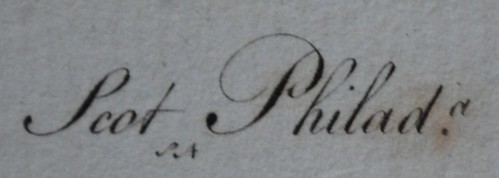
Joe Boling writes:
Those Shallus medals looks like one-offs - hand-engraved awards. It may be that Shallus was not a medallist of the stripe we think of, but a plate engraver who occasionally turned his hand to medals. Dick Johnson - is there a distinguishing adjective to describe an engraver of that sort?

I passed Joe's query on to Dick Johnson, who writes:
They have been called "hand engravers" throughout history, from ancient coin die engravers until today's Ron Landis. We have always had hand engravers no matter how man has tried to mechanized -- or computerize! -- the craft. And hopefully we will not lose this craft in the future.
If you stop by the bourse table (#1230) of Signature Art Medals at the Boston ANA convention in August you will see a hand engraved medal to be issued next March 4th for the 150th Anniversary of Abe Lincoln's Inauguration. We are trying to keep this craft alive by issuing hand engraved medals even in the 21st century! (We will also exhibit die-struck, cast and galvano medallic art as well. Oops! Wrong word! These medals are for sale, not just on "exhibit.")
As for Shallus and his 1790s period in early America you must remember they were not as specialized as we are today. Anyone who could hand engrave was called upon for their service no matter what the need. This extended from engraved pew plates -- your seat in church was reserved just for you -- to monogrammed silverware, to initial door knockers, to currency or map plates, to book illustrations and plates, to signet rings, to the dies used for striking coins and medals. Hand engravers were even called upon to engrave the cylindrical rollers to print wall paper in the 1800s!
Today's hand engravers, it seems, concentrate on engraving firearms. That's were the money is! There are 500 firearm engravers to every one die engraver. Viva la hand engraving!
To read the earlier E-Sylum article, see: QUERY: FRANCIS SHALLUS, PHILADELPHIA ENGRAVER (www.coinbooks.org/esylum_v13n19a23.html)
UNKNOWN COPPER COIN IDENTIFIED AS AMERICAN GAMING COUNTER
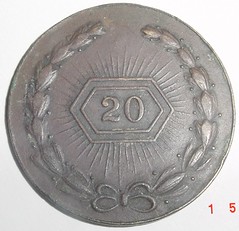
Joe Boling writes:
The piece is described as having "the same design is on both sides, except that the initials JS are at the bottom on one side." It's Josef Stalin's pocket piece, of course. Makes as much sense as the conspiracy theories about John Sinnock's initials on the Roosevelt dime.
Joe Levine writes:
The unknown copper token is the interior of the reverse of what Rulau/Fuld call a Radiant Eagle Counter (Rad-14). These pieces apparently come with an additional border around them.
Ken Barr writes:
The illustrated item is an American gaming counter, $20 (double eagle) denomination.
These items are cataloged in "American Counters, Part 1, Double Eagle and Eagle Gold" by L. B. (Benj) Fauver, privately published, 1983.
The specific item is listed as "20"-2005 / "20"-2010 (34 mm, plain edge, issued in both brass and gold-plated brass versions).
It's fairly common (despite a high rarity rating in the catalog), and probably worth in the $10 - $15 range these days.
To read the earlier E-Sylum article, see: QUERY: UNKNOWN COPPER TOKEN IDENTIFICATION SOUGHT (www.coinbooks.org/esylum_v13n19a16.html)
ABOUT THAT GIANT CHINESE COIN...
 Martin Purdy was the first to comment. He writes:
Martin Purdy was the first to comment. He writes:
I trust you realise this is Vietnamese/Annamese, not Chinese. (And the coin is upside down in the picture!)
Ron Haller-Williams writes:
If the fact that a coin has Chinese writing on it were to make it a Chinese coin, then you folks in the USA would still be using "ENGLISH" coins. Even the link gives a clue - VIETNAM.blogspot.com !
According to http://en.wikipedia.org/wiki/Ha_Tinh_Province "Ha Tinh (in Vietnamese Hà Tĩnh) is a province on the north central coast of Vietnam." (my emphasis)
China never had a Le dynasty. The (Later) Lê Dynasty ruled Vietnam from 1428 to 1788 (called "Later" to distinguish from the Early Lê Dynasty 980–1009), and the monarch Canh Hung ruled there, as indicated, from 1740 to 1786.
A good source of information on the regular coins of his reign is to be found at http://www.history.ucsb.edu/faculty/roberts/coins/Canhhungcoins.html
It's a great pity that the coin is upside-down in the photo (also in the source article).
Oh, and considering that a silver dollar/crown/yuan/tael with a diameter of 3.8 cm weighs about 27 grams, I'd expect a 12cm cast coin to weigh well over 30gr !!! Even at 130 grams it might be too fragile.
The same problems (upside-down; light weight) also apply to the other sources I have found.
Howard A. Daniel III writes:
I would be very surprised if the "coin" in the Giant Chinese Coin of Le Dynasty Found item in last week's E-Sylum is authentic.
A few years ago, my wife was traveling without me to visit an important Buddhist temple in the Mekong Delta, while I was in Saigon (Ho Chi Minh city) doing something else. After her religious duties, she wandered into a side building, which happened to be a gift shop for tourists. In one area, there was a large display of "giant cash-style coins" and she got very excited. She took a picture and showed it to me once we were back together.
She told me the temple was selling them to tourists for US$2 to US$5 each, and quantity was available for dealers who wanted to resell them in their stores! Did I want to get in on these very rare coins at such a low price?
I saw my first pieces sometime in the 1980s at a coin show in New Carrollton or Baltimore, MD. I got quite excited and almost paid the dealer $125 for one without studying the "coin." After looking at it for a few minutes, I could see the patina was artificial and the scene (there are not characters on the reverse of all of them) was of a palace built AFTER the reign title on the coin. My heartbeat slowed down and I declined to buy the coin.
I believe this story about the giant Chinese "coin" is about a "planted" coin suddenly "found" to drum up a "high-priced sale" for someone. The person is so knowledgeable about it that it is shown upside down and identified as Chinese. And it might be Chinese-style but it has the reign title of the Vietnamese Emperor Canh Hung!
Over the past 10-15 years, I have acquired a collection of them at "tourist" prices from Canh Hung all the way to Bao Dai (200 years of rulers), the last Emperor of Viet Nam. We in Vietnamese numismatics call them "mantle pieces" as they are placed on a mantle or on the family altar (often in a holder to display dishes) to show respect for a particular Vietnamese Emperor.
As a matter of fact, Canh Hung is my favorite Vietnamese Emperor because he is issued the highest number of different coin varieties......but the "coin" in this item was not one of them.
To read the earlier E-Sylum article, see: GIANT CHINESE COIN OF LE DYNASTY FOUND (www.coinbooks.org/esylum_v13n19a24.html)
THE BOOK BAZARRE
A PRETTY BOOK: HOMER R. STEPHENS' DALTON & HAMER
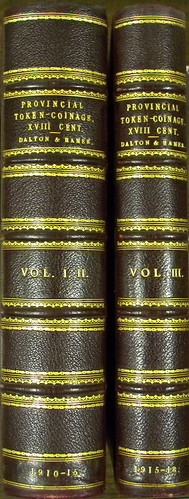
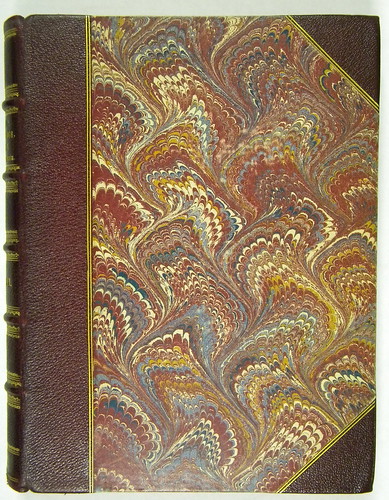
642 Dalton, R. and S.H. Hamer. THE PROVINCIAL TOKEN-COINAGE OF THE 18TH CENTURY. ILLUSTRATED. Entered at Stationers' Hall, no place of publication, 1910–1918. Fourteen parts complete, as bound in two volumes. Small 4to, contemporary or slight later red half morocco with marbled paper sides; gilt double fillets on sides; five raised bands decorated in gilt, second and fourth resulting panels lettered in gilt; tails dated in gilt; marbled endpapers; all edges red. 567, (1) pages + titles and preliminary text to the various parts; finely illustrated throughout. Only slight rub to lower extremities. A fine set. (1000.00)
A beautifully bound set of the rare original edition. Ex Homer R. Stephens, with his original receipt dated July 30, 1936 from Wayte Raymond, and Raymond's original receipt from Bernard Quaritch, London, dated July 13, 1936. Still the indispensable standard reference on this captivating series. The illustrations are photographically-printed and are superior to any of the reprints. Clain-Stefanelli 13878*. Grierson 252.
MORE ON THE 2008 SPECIAL EDITION RED BOOK
Last week, regarding the 2008 special edition "Red Book" Dennis Tucker wrote:
The 2008 ANS Limited Edition will probably be very rarely seen in the marketplace, since it was distributed to a small number of people for their personal collections. It was never offered for sale; each recipient got one (and only one) copy, as a memento of a historic occasion (the sesquicentennial of the American Numismatic Society). It might be a generation or two before any copies appear publicly for sale or auction."
David Gladfelter writes:
A copy of this edition was given to each member who attended the American Numismatic Society's banquet in 2008. My wife, who is neither a member nor a collector, but a good sport nevertheless, came with me to the banquet and also received one. We donated her copy to NBS to be auctioned as a fund raiser. With Brad Karoleff taking (extracting?) the bids, it brought a humongous price. So there has been at least one appearance on the secondary market but don't take Brad's price realized as a market indicator.
You had to have been there. I'm told that Brad has a night job as a stand-up comic. He had John Adams diving for cover under the table during the club benefit auction. I did go up to thank the guy who bought it (for something north of $1K). He was very good natured – think he actually enjoyed parting with that much cash to benefit NBS.
That's one of my Red Books that I treasure. The other is the 2004 regular edition short-snorter signed by everyone in attendance at the 2003 NBS meeting in Baltimore, including yourself of course, and all the other good guys. I got that one for ~$100 if memory serves. Well worth it.
David Fanning writes:
I sold a copy in my first auction sale, held in October 2008 (lot 304).
304. Yeoman, R.S. A Guide Book of United States Coins. 61st edition (2008). Kenneth Bressett, ed. Atlanta: Whitman, 2007. 8vo., full leather, gilt; gilt page edges; silk bookmark. Limitation leaf; 416 pages. American Numismatic Society 150th anniversary celebration bookplate on pastedown. Fine.
One of 250 copies prepared with a special bookplate in honor of the ANS's sesquicentennial, of which this is copy 158 (and copy 643 of the 3000 printed of the 2008 limited edition Red Book).
To read the earlier E-Sylum article, see: QUERY: 2008, 2010 SPECIAL EDITION RED BOOKS (www.coinbooks.org/esylum_v13n19a14.html)
MORE ON HOWARD GIBBS, "THE DUDE ON THE CAMEL"
Angelo Cilia writes:
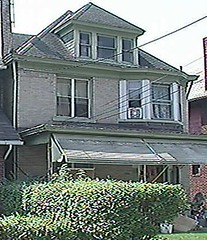 I thought readers might like to see 1112 Berkshire Ave, the home of Howard Gibbs in Pittsburgh. This image is taken from the Allegheny County Real Estate website. I grew up near there.
I thought readers might like to see 1112 Berkshire Ave, the home of Howard Gibbs in Pittsburgh. This image is taken from the Allegheny County Real Estate website. I grew up near there.
Property tax web sites are a great way for voyeurs and researchers alike to view images of homes and other properties owned by hobby figures. See this week's Featured Web Site for another useful online resource. -Editor
David Gladfelter writes:
August 15, 1964 was in fact a Saturday. But the card was mailed from Pittsburgh, not Cairo, on August 4, 1964. So we only can answer two of your questions – who it is and where it was taken. We still don't know when it was taken.
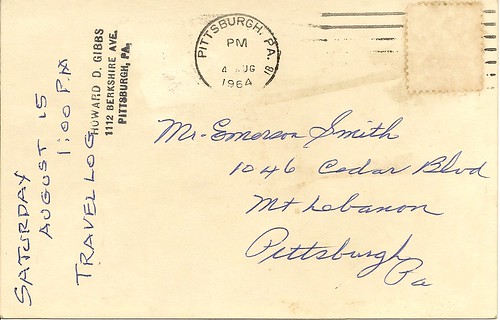
Ron Haller-Williams writes:
What if the card had been lying around for some years before getting posted? We ought really to check the photo against a 1950s photo, that Mr Gibbs here looks about 10 years older in the picture than he had at the Farouk sale. Also, the dates appear somewhat suspicious - the card was NOT sent from Egypt, and has mention of something 11 days after the postmark date.
Joe Boling agrees
Just because the Gibbs postcard was mailed (in the US, no less) in 1964 does not mean that the photo was not taken in 1954. The date Saturday August 15th is evidently not the date of the photo, but of the day Gibbs was going to present a travelogue to some friends - eleven days after the card was postmarked.
Do we have any other evidence that he traveled to Egypt in 1964? He could have had any number of copies of this card made in 1954.
Occam's Razor states that the simplest explanation that fits all of the facts is the most likely one. So taking all these facts into consideration, it seems that Gibbs mailed this card from Pittsburgh in 1964 to invite some friends to his house for a travelogue, which likely included highlights of his 1954 trip to Egypt. The jury is still out on when the postcard photo was taken - all we really know it that it was taken before the postmark date. Thanks again, everyone! -Editor
To read the earlier E-Sylum article, see: QUIZ ANSWER: WHO IS THE MYSTERY NUMISMATIST? (www.coinbooks.org/esylum_v13n19a07.html)
QUICK QUIZ: ANOTHER MYSTERY NUMISMATIST
Dave Lange submitted a new mystery numismatist quiz for us. He writes:
The man in this Christmas photo had a great impact on the hobby of coin collecting in the USA.

NOTES FROM E-SYLUM READERS, MAY 16, 2010
Numismatic literature dealer John Burns will be setting up shop at the Whitman Coin & Collectibles Nashville Expo May 20-22. Stop by, say hello, and buy a book or two.
On the release schedule for the new $100 bill, Joe adds:
I agree with Dick Hanscom. With all the security that the government imposed on the design of the new $100 note (with green tarps all over the Ft Worth plant when the ANA tour went through in March), allegedly to limit the amount of time that counterfeiters would have to work on the new design before it gets into the public's hands, I am amazed that the notes will not be released until February 2011.
I have already heard one numismatic writer opine that there will be a stack of garden-variety fakes in the coming months, pushed by folks with the line "this is the new hundred - don't you remember hearing about it?"
Dave Lange writes:
A few observations relating to the most recent issue:
Adding to Bob Neale's comments on the subject of President Cleveland's replacement of the Carson City Mint Staff and suspension of coining there 1885-89, Cleveland had the final word when he again became president in 1893. He saw to it that coining there was terminated permanently, and all it took was to eliminate funding for coining operations in the Fiscal Year 1894 budget.
As for the politics of U. S. Mint staffing, it has been the norm for more than 150 years for the director and superintendents to be replaced by members of the victorious presidential party. In the Victorian period this purging was extended to even lower level employees, as is revealed in the Daggett book, but today these people are long term civil servants whose skills and experience are not lost with every sway of the political winds.
Regarding the possible elimination of the cent in Canada: If properly informed of the economic facts, Americans, too, would likely choose to live without pennies, but this is never the case. Every survey on the subject has been sponsored by some organization that has a vested interest in maintaining cent production, and the questions are always slanted to suggest that the outcome would be inflationary.
Lobbying by the zinc industry is behind most such activity, but the reluctance of our government to accept downsizing at the various U. S. Mints is also a factor. The current reduced demand for coinage is a trend which is likely to continue as long as Congress fails to cease production of one-dollar notes, while simultaneously failing to authorize higher denomination coins and eliminate the obsolete lower denomination coins.
Our coinage system is in an absolute shambles, and both businesses and taxpayers are absorbing the loss that results from so many useless coins and so few denominations that actually circulate effectively.
On the subject of Virginia's state seal, I was surprised that it carries the same inscription as shouted out by assassin John Wilkes Booth as he leaped from the balcony of President Lincoln's theater box: "Sic Semper Tyrannis." Booth was from Maryland, but it is perhaps ironic that he died in Virginia.
Alan V. Weinberg writes:
Sarah (not Sally) Freeman was the curator of the Johns Hopkins Garrett Library. I met her in 1967 when I spent a splendid day at Evergreen House examining the American coins in old fashioned coin cabinet trays while I sat at the Evergreen House's John Work Garrett massive desk. Sarah would bring two or three trays to me at a time. Everything was raw, to be lifted by one's fingertips out of the tiny tray "cubicles".
The late Carl Carlson, later of Stack's, was the Evergreen numismatic curator shortly before the Garrett collection came to Bowers & Ruddy for sale. I believe it was his ill-advised private trades to Dick Picker and a few others that resulted, at least in part, in his Evergreen dismissal and ultimately the sale of the remaining collection.
Regarding the earlier BBC News numismatic quiz, Jim Duncan of New Zealand writes:
I ran your recent quiz by the members of the Numismatic Society of Auckland at their last meeting - one member, Glyn Tunley of Wales via South Africa - scored the perfect 7. He said he had just been given a £20 note.
To read the earlier E-Sylum article, see: WHO PASSED THE BBC NEWS NUMISMATIC QUIZ? (www.coinbooks.org/esylum_v13n17a16.html)
THE MERCATOR MEDAL OF DRAKE'S WORLD CIRCUMNAVIGATION
Alan V. Weinberg writes:
The massive Michael Mercator silver engraved medal depicting Sir Francis Drake's world circumnavigation is one of the premier medals in the world. I distinctly recall reading a pictorial article in a 1960's Coin World announcing its auction sale in London for then $50,000 US. I always wondered where it went. Now I know. England's Greenwich Maritime Museum. It is a million dollar medal today.
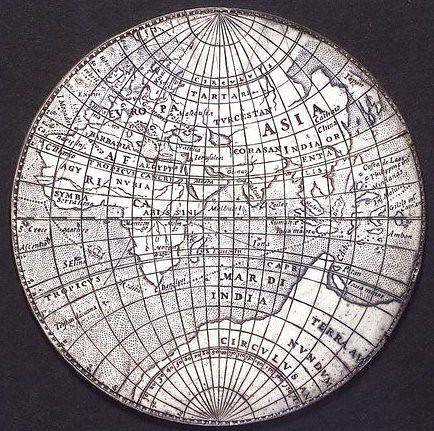
Medal commemorating Sir Francis Drake's voyage, 1577-1580. 'TROPICVS' type. On a silver plate, on one side the eastern hemisphere and on the other the western, showing the track of Drake's voyage. Nine examples of this commemorative medallion are known. One of the nine, formerly in the collection of the Earl of Caledon, has a cartouche identifying the maker as Michael Mercator, grandson of the Dutch cartographer, Gerard Mercator the elder. It indicates that the medallion was sold in London in 1589. There is some evidence that they were cast from an engraved original. Drake's route is indicated by a dotted line with tiny ships. The date of his landing on the Californian coast is given incorrectly as 1580 instead of 1579.
To read the medal's online collection entry, see: Medal commemorating Drake's voyage, 1577-1580 (MEC0004) (www.nmm.ac.uk/collections/explore/object.cfm?ID=MEC0004)
Alan V. Weinberg adds:
I recall a while ago I saw a claim in print that a Museum claimed nine are known. Quite impossible. I've seriously collected medals for over 40 years, receiving many European sales catalogues in that period and no original silver engraved Mercator medals have ever appeared at auction in my lifetime, to my knowledge, aside from the piece that sold for $50 grand back in probably the late 60's.
The medal is intricately and minutely hand engraved with countries and continents' names and other minute details - painstakingly engraved. It is so unlikely the engraver made more than one - let alone nine still extant- and each medal would by its very nature be dramatically different and unique in its engraving.
However, I have seen one or two later engraved silver copies of the Mercator (I owned one decades ago) and presumably, if any are in the British Museum (likely), there were electrotypes made as the BM often did. But nine originals - even half that known - strains credibility.
I know who might know if there is more than one over in Europe - the much traveled medal connoisseur Dick Margolis who receives The E-Sylum.
When I was living in London in 2007, E-Sylum readers Phil and Harry Mernick treated me to a wonderful day of sightseeing which included the National Maritime Museum and the Royal Observatory in Greenwich. I highly recommend these sights to visitors. Check out my London diary for some interesting "secret" passageways most tourists miss. -Editor
To read the diary of my visit to Greenwich, see: WAYNE'S LONDON DIARY 1-2 SEPTEMBER, 2007 (www.coinbooks.org/esylum_v10n35a14.html)
To read the earlier E-Sylum article, see: FEATURED WEB SITE: NATIONAL MARITIME MUSEUM (www.coinbooks.org/esylum_v13n19a30.html)
QUERY: ANA PIONEER GEORGE W. RODE
Here's one research project I could use some help with myself. A while back I promised to write an Asylum article on George W. Rode, an early officer in the American Numismatic Association. I finally got around to starting on it this week, and quickly realized I have several holes to fill in the story. Perhaps some of you can help.
First, there's the issue of how one pronounces the name "Rode". His parentage is German, if that helps. I've always pronounced it like "Road", but "Roadie" is another possibility. This may well stay a mystery.
More importantly, I'd like to learn his birth date and confirm his date of death. These should be much easier to find now using online resources unavailable to me in 1992, when I first wrote about Rode in my history of the Western Pennsylvania Numismatic Society, where he was a founding member in 1878.
Here's what I know so far, thanks to the help of ANA Library Manager RyAnne Scott and ANS Librarian Elizabeth Hahn: Rode was born in July, 1858 and died July 30, 1904.
By locating his dates of birth and death we may also discover his middle name. Just what does the "W" stand for?
Rode had a numismatic library, and I'm curious to know what all was in it. One of his books is in my library today - a bound volume one of The Coin Collector's Journal (1876).
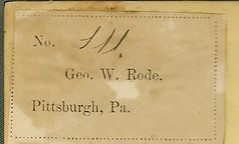 Here's Rode's bookplate from that volume. If you have any of Rode's books in your library, please let me know. Literature dealers - if your sale catalogs mention bookplates or prior owners, please search your computer files for Rode's name.
Here's Rode's bookplate from that volume. If you have any of Rode's books in your library, please let me know. Literature dealers - if your sale catalogs mention bookplates or prior owners, please search your computer files for Rode's name.
If this book was item number 111, then it's likely there were at least that many books and catalogs in the library (probably many more). And that's a big number for a collector who died in 1904, before there were many coin books to be had. A good number of the items were probably auction catalogs.
According to a note in the July 1883 Numisma, the Woodward sale of May 2,3,4 1883 offered Rode's "collection of catalogues & etc.". He would have only been about 25 years old at the time and would remain active in numismatics through at least the 1890s, with the founding of the American Numismatic Association. Does anyone have a copy of this Woodward catalog handy?
Lastly, I'd love to locate a photo of Rode. For this, I may have to track down one of Rode's descendants. According to his obituary, he had one son and one daughter. Online Pittsburgh telephone directories list five people with the last name of Rode, so writing or cold calling them is an easy option, even if it's a likely longshot.
That's not a lot to ask, is it? OK, it is. But it never hurts to ask, so if anyone out there can help with one of these items, I'd be pleased to hear from you. I can be reached at whomren@coinlibrary.com. Thanks!
To learn more about George Rode and WPNS, see: The Early History of the Western Pennsylvania Numismatic Society (www.wpns1878.org/history.html)
MORE ON THE BASHLOW CONFEDERATE CENT RETSRIKES
I was interested to see the Bashlow Confederate Cent Restrikes surface once again as a topic in The E-Sylum. It is a favorite subject and I am always interested in news about them.
About ten or twelve years ago I tried to assemble a collection of the three standard metal versions through on-line auctions, and I was able to get a few copies of the bronze and one of the Goldine. I never was able to outbid anyone on the silver. The prices for these restrikes seem to have risen steadily over the past several years, perhaps partly due to NGC's willingness to slab them. I imagine that at some point I will have to pay “real” money to get a silver version and complete the set.
About ten years ago, when I was actively scouring eBay for the Bashlow Confederate Cents, I ran across a tin example in its original Capitol three-layer Plexiglas holder. Somehow I managed to come out on top at around $35. I recall having lingering doubts about whether or not I might have slightly overpaid for that one, but based on where prices have gone for even the common restrikes I guess it was money well spent.
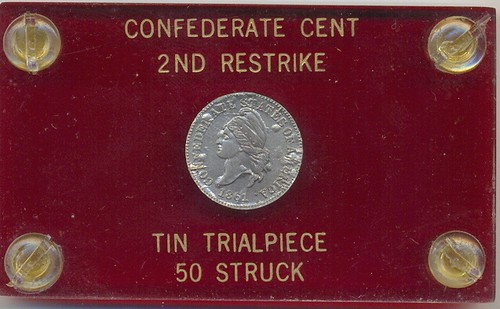
Incidentally, when I was a kid in the 1970s I recall Littleton Coin Company selling these restrikes in their original manila envelopes. I am sure their price seemed exorbitant at the time, but I sure wish I had built a set of them back then.
To read the earlier E-Sylum articles, see:
GOLD CONFEDERATE CENT RESTRIKES
(www.coinbooks.org/esylum_v13n19a10.html)
QUERY: CONFEDERATE CENT RESTRIKES IN OTHER METALS SOUGHT
(www.coinbooks.org/esylum_v13n19a11.html)
THE EMERGENCY MONEY COLLECTOR, VOL. 2 NO. 3
This article appeared in the May 10, 2010 issue (Series 11, No. 1929), and completes the series. Thanks, Warner! To subscribe to the MPC Gram, write to MPCGram@yahoo.com. -Editor
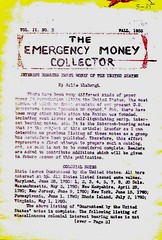 The Emergency Money Collector
The Emergency Money Collector
VOL. II NO. 3 Fall 1953,
by Warner Talso
Arlie notes that West Virginia is suffering a heat wave. Temperatures up to 102 Degrees F. This makes working very hard and he has reduced this issue to 20 pages.
The feature article is “Interest Bearing Paper Money of the United States” by Arlie Slabaugh. This seven page article covers colonial notes, USG issues, CSA issues, state, county and city issues, and private issues (by loan companies and railroads). He mentions depression scrip and says that is a whole area of interest of its own.
Chapter V of “Russian Emergency Paper Money” by Vladimar M. Oushkoff is presented. This chapter discusses the issues of Central Asia. This region is remarkable for the number of issues and the use of silk instead of paper. Also, text is often in Arabic, rather than Russian. The author notes an interesting problem around 1921. At the time, notes were hand printed using engraved wooden plates. This is a slow process. A period of “wild inflation” ensued and printers could not keep up with quality printing. The result was smeared, partially printed notes that were barely readable. In 1922, a printer was hired to use lithography in the printing of currency.
Semirechye is a remote region on the Chinese border. Their currency was backed by opium stored in the State Bank vaults.
The British troops in Afghan Territory helped the Transcaspian Government by providing them with 500 roubles notes.
These are but a few examples of wide variety of interesting features of emergency currency in this region during the early 1900s. The author promises more in the next issue of this publication. (However, see below.)
An article, Some Emergency Issues of the Bank of France, by Arlie Slabaugh, discusses notes issued by the Bank of France (founded in 1800) through WWI. Arlie offers for sale the local emergency scrip issued in Boise Idaho during WWII. During the “penny shortage”, these one cent small square scrip were printed. Now scare, Arlie offers them for sale at 2 for 25 cents.
Arlie lists his books, “Emergency Monies of the World, 1914-1924” and “The German Inflation”, that are for sale: The man certainly was a prolific writer.
Alas, this is the last issue of this publication. Arlie alludes to the next issue. He apparently had no plans, at that time, to discontinue publication. I wonder what happened.
To read the earlier E-Sylum article, see: THE EMERGENCY MONEY COLLECTOR, VOL. 2 NO. 2 (www.coinbooks.org/esylum_v13n19a17.html)
THE PICTURE OF DORIAN GRAY, NUMISMATIST
 Last night I watched the movie, "The Picture of Dorian Gray" (1945), on TCM (Turner Classic Movies). This was probably only the second time in my memory that I had seen this film.
Last night I watched the movie, "The Picture of Dorian Gray" (1945), on TCM (Turner Classic Movies). This was probably only the second time in my memory that I had seen this film.
There is a scene in the film where Dorian is approached by the painter of his portrait, Basil who arrives to question Dorian about rumours of his indulgences.
In the scene Dorian walks over to a large wall cabinet and takes from it a large book, a box with a handle on the top of it and a jeweler's tray.
He sits down at a table, opens the book and the box and sets down the tray. The jeweler's tray has many coins in it. From the box with the handle on top he pulls out three wooden trays with circular impressions on them that are empty. It's a coin cabinet.
The book he has opened has a picture of a plate of many coins.
While Basil is questioning him, Dorian picks up coins from the tray and looks at each with a small magnifying glass and then looks through the plate of coins and once identified he sets it into a blank opening in the coin tray. This goes on for a good five minutes.
This was the first time that I had ever seen a display of a numismatic setting in a film. Has anyone else seen this film and noticed that particular scene?
The DVD is available for this film. It is the 1945 version. YouTube has clips of the movie but not of that particular scene.
To view the YouTube clip, see: The Picture of Dorian Gray 1945 (www.youtube.com/watch?v=u7bjLB5qQqU&feature=related)
A BLOG ABOUT BOOKS: EBOOKS AND PRINT ON DEMAND
Dick Johnson writes:
Look what I found -- on a library book blog, a virtual cornucopia of articles on eBooks and print-on-demand books. Here's a cafeteria of reading on so many aspects of new book trends. Isn't it exciting to be a book reader with this new technology?

We are getting a lot more cancellations lately for books which we order. I think this is due to print on demand. Publishers have much tighter control of how many books can get printed with print on demand, they can track the number of books ordered and more closely match print runs with what is being ordered in a more timely manner. This means there can be a much quicker decision about canceling titles and inventory. If there are not enough orders for a book it will be cancelled much quicker than before.
This means a lot less books are kept in inventory. Machines like the Espresso Book Machine can print a trade paperback in four minutes from a digital file. Google Books is partnering with the Espresso Book machine to be able to print and sell books quickly. This includes a huge number of public domain books at a very reasonable price. http://www.wired.com/epicenter/2009/09/google-books-publish-on-demand/
There is a second thing which is happening, one of the largest distributors for books, Ingram, owns Lightning Source which is the largest print on demand publishing source. Lightning Source has also partnered with Baker and Taylor for distribution. They are now printing to order as people buy the books, the warehouse prints then sends them. It is called Print to Order. This eliminates lots of inventory and saves money for the publisher. http://finance.yahoo.com/news/Baker-Taylor-and-Wiley-Ink-prnews-579997220.html?x=0
Print to Order is not just for publishers, libraries and bookstores are putting print on demand stations inside their buildings as well. This is a short article on the growth of print on demand which shows its growth in the last five years 2005-2010 http://www.infotrends-rgi.com/public/Content/INFOSTATS/Articles/2006/09.05.2006.html
The other area which is growing is ebooks. In a way ebooks obscure the growth of print on demand. People are adapting ebooks very rapidly. There was a 307% increase in sales this January over January of last year. http://ereads.com/2010/03/january-10-e-book-sales-almost.html
To read the complete blog post, see: Ebooks and Print On Demand (bookcalendar.blogspot.com/2010/05/daily-thoughts-592010.html)
HARVEY STACK: ACTION NEEDED AGAINST COIN FAKES AND REPRODUCTIONS
 I just received my copy of the Coin World, April 26 edition, and I was proud to be part of the special front page story about the counterfeit display at the Federal Reserve. I read with great interest the complete story about counterfeiting and how our government agencies can react.
At the present moment, the counterfeiters are at it again, making $100 Bills which are undermining U.S. currency.
I just received my copy of the Coin World, April 26 edition, and I was proud to be part of the special front page story about the counterfeit display at the Federal Reserve. I read with great interest the complete story about counterfeiting and how our government agencies can react.
At the present moment, the counterfeiters are at it again, making $100 Bills which are undermining U.S. currency.
It is no different with the counterfeit coins that are now coming from China. They are HURTING those who obtain them and dilute the rarity and desirability of COLLECTIBLES like the coins that they are now falsifying. Yet our government agencies are not enforcing their right to restrict them from coming into our country.
WHO IS THERE TO PROTECT THE INNOCENT COLLECTOR? Why this passive approach to the problem? Is it the lack of knowledge - that THEY don't know the difference between GOOD or BAD, or is the collector deemed not important?
This matter is a lot worse than people think. The flooding of false coins to the public by the eBay advertisers and promoters is flooding the market with FAKES and watering down the importance of original coins.
This type of problem occurred after World War II, in the late 1950's and again in the early 1970's, and regulations and laws were enacted to try to protect the integrity of the original issues.
I must emphasize that should the integrity be violated or abused with impunity then Coin Collecting as we know it will go down as did the other collectibles have, when the importance of ORIGINAL is diminished by counterfeiters and reproducers.
Readers of The E-Sylum and other collectible publications should be continuously made aware of the dangers around them. E-Sylumites have a high degree of respect for the hobby, and it is appropriate for them to be part of a support group that makes the dangers that are occurring before them evident to all they know.
For many years of my life I attempted to work towards the advancement of the hobby. The present situation is just another attempt by profiteers to make money while destroying the hobby we all love.
Sorry to sound so strong on this subject, but the hobby and its collectors were always good to me, and I try to show my appreciation by championing causes such as this.
THE BOOK BAZARRE
JACOBS PERKINS PRINTING AND ENGRAVING BUILDING OPENS
It's been a day decades in the making.
After a year of intense work, the first phase of the restoration of the historic Jacobs Perkins Printing and Engraving building is complete.
And tomorrow, it's time to celebrate.
The Historical Society of Old Newbury, Cushing House Museum, will be holding a ceremonial ribbon cutting at 1 p.m. to honor the purchase and first phase of restoration of the mint.
"It's been years in the process ... it's actually been decades," said Jay Williamson, Historical Society of Old Newbury curator.
In 2007, the Historical Society of Old Newbury was able to purchase the building from then-owner James Lagoulis using a $200,000 grant from the Newburyport Five Cents Savings Bank. The society also received a $184,500 grant through the Community Preservation Act to cover the cost of the restoration.
The building on High Street — the address was recently changed — housed the first mint in Massachusetts in the early 1800s when Jacob Perkins printed currency for the state and other parts of New England. It abuts the rear of the Historical Society building on the corner of High and Fruit streets.
It is the oldest surviving printing/engraving plant in the country.
Last spring, contractors began the project, which included replacing sheeting and doing beam repairs. The timber framing on the second and third floors was also restored, and the brickwork was re-pointed.
The goal was to restore the building's external appearance to its original look.
 "Right now, the building is stable. It's well-preserved, so that stage is 'mission accomplished,'" Williamson said. "It was a community effort from start to finish."
"Right now, the building is stable. It's well-preserved, so that stage is 'mission accomplished,'" Williamson said. "It was a community effort from start to finish."
Following the ribbon cutting, participants are invited to tour the mint with the Historical Society and the Newburyport Five Cent Savings Bank before heading to the Firehouse Center for the Arts where Dr. James Haxby, an obsolete bank note expert, will give a lecture on Perkins and the birth of currency in the United States at 3 p.m. Admission is free, but participants must first visit the Perkins building, due to the limited number of seats at the Firehouse.
Jacob Perkins would be proud.
To read the complete article, see:
Historic mint is restored, reopens this weekend
(www.newburyportnews.com/local/x334292062/Historic
-mint-is-restored-reopens-this-weekend)
WALL STREET JOURNAL: U.S. PLANNING COIN COMPOSITION CHANGE
 It costs the federal government up to nine cents to mint a nickel and almost two cents to make a penny. So, in addition to overhauling Big Finance, President Barack Obama wants to tinker with America's small change.
It costs the federal government up to nine cents to mint a nickel and almost two cents to make a penny. So, in addition to overhauling Big Finance, President Barack Obama wants to tinker with America's small change.
The president's plan to save money by making coins from cheaper stuff seems simple on its face. But history shows it would rekindle an emotional debate among Americans who fear changing the composition of their currency will hurt its value.
As the White House looks to cut costs across government, "making coins from more cost-effective materials could save more than $100 million a year, which isn't just pocket change," says Dan Tangherlini, the Treasury Department's chief financial officer.
The government isn't saying which new materials it might use in coins. Most coin experts say creating non-metal coins would go over like a wooden nickel. Still, industrial porcelain, embedded with an identification chip, is seen as an outside possibility. A more likely candidate: an aluminum alloy, used by other countries for coins. But any switch is likely to be controversial.
No other stable nation has changed the metal content of its coinage less frequently. World War II shortages compelled the creation of a steel penny in 1943. The mint returned to copper after a year, even though that required smelting spent shell casings. The nickel's composition has gone unchanged since Thomas Jefferson's likeness was put on the coin in 1938, again with the exception of World War II, when for a brief period silver was added, because nickel was needed for weapons production.
A least one group would support a sweeping change in the nation's coinage. Nickel, the most expensive and commonly used metal at the mint, is also the most allergy-producing metal in the world. According to the American Academy of Allergy, Asthma & Immunology, people allergic to nickel who have sustained contact with the metal—used in nickels, quarters and dimes—develop an itchy, poison-ivy-type reaction that can last up to a month.
"My husband always has these weird rashes on his leg from the change in his pocket," a treasury official involved in the coinage plans says. "Maybe he would benefit from a plastic quarter."
To read the complete article, see: Will Nickel-Free Nickels Make a Dime's Worth of Difference? (online.wsj.com/article/SB10001424052748704866204575224431682671088.html)
David Gladfelter adds:
I say, let's get rid of the mill. We would have to fight the gasoline retailers lobby on that one.
HOMETOWN OF U.S. GRANT LOBBIES TO KEEP HIM ON $50 BILL
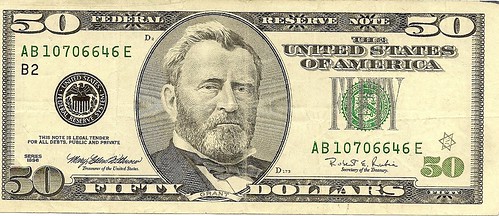
With very little discussion and comment, the Galena City Council voted unanimously to approve a resolution opposing the redesign of the $50 Federal Reserve Note.
The proposed new design would feature a portrait of the late Ronald Reagan, rather than General and former President U.S. Grant.
The resolution, drafted by Galena City Administrator Mark Moran, is written in the stately Johnsonian style appropriate to such documents, states that Patrick McHenry, a Republican congressman from North Carolina, has gained the support of 13 other members of the Republican party to create a bill proposing Ronald Reagan to replace President Ulysses S. Grant on the $50 bill.
This bill has become known as HB 4705 and has been introduced in congress and is currently in the House Financial Services Committee.
Further, the resolution states that "the city of Galena, Illinois, holds a special place in the history of our nation by having the distinct honor of being the pre-Civil War home of Ulysses S. Grant.
It states further that the city of Galena takes great pride in the fact that the 18th president of the United States graces the $50 bill and represents the strength and spirit of the American people.
The resolution points out that the decision to place Grant on the $50 bill was not a hasty or trivial decision, and that Grant first appeared on US currency in 1914, nearly 30 years after his death and with a half century of perspective on his Civil War accomplishments.
To read the complete article, see: Galena City Council wants U.S. Grant on $50 bill (galenagazette.com/main.asp?SectionID=142&SubSectionID=344&ArticleID=15066)
LARGEST BYZANTINE COIN HOARD UNCOVERED IN MACEDONIA
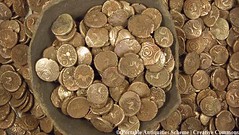 The landfill with coins recently discovered at the Skopje Fortress is the biggest repository of Byzantine gold and silver coins ever discovered on the territory of Macedonia, archaeologists told national media today.
The landfill with coins recently discovered at the Skopje Fortress is the biggest repository of Byzantine gold and silver coins ever discovered on the territory of Macedonia, archaeologists told national media today.
In the chest, archaeologists found 44 gold coins and 76 Venetian coins, dating to the thirteenth century, or the Byzantine Era.
This is the most significant archaeological find at the Skopje Fortress, along with the Medieval lead stamps that were discovered several years ago at the site, Pasko Kuzman, archaeologist and Director of Cultural Heritage Protection in the Macedonian Ministry of Culture, told the Vreme newspaper.
Golden Byzantine coins have been unearthed at other sites in Macedonia, but rarely and in smaller quantities, he added. According to archaeologists, large quantities of bronze coins are often found at ancient sites around Macedonia.
The newly discovered gold coins are stamped with images of Byzantine kings and Biblical motifs, while the Venetian silver coins are stamped with the images of Venetian leaders.
It is interesting that hundreds of coins were found in a small box, meaning that they were carefully kept and had great value for people of that time, Kuzman noted.
To read the complete article, see: Archaeologists Unearth Biggest Stash of Byzantine Coins Ever Found in Macedonia (www.balkantravellers.com/en/read/article/1954)
ABU DHABI VENDING MACHINES TO DISPENSE GOLD
 Abu Dhabi's top hotel is upping the ante in the race for Gulf glitz: adding a gold-dispensing machine.
Abu Dhabi's top hotel is upping the ante in the race for Gulf glitz: adding a gold-dispensing machine.
The ATM-style kiosk in the Emirates Palace monitors the daily gold price and offers small bars up to 10 grams or coins with customized designs.
It's the idea of a German entrepreneur, Thomas Geissler, who began testing the cash-for-gold machines in his native country in 2009. The Abu Dhabi debut on Wednesday is billed as the first international foray for Geissler's "Gold to Go" brand.
Geissler says he picked Abu Dhabi because of its high-rolling atmosphere and the region's traditional ties to gold in commerce.
To read the complete article, see: Abu Dhabi Hotel Has Gold Dispensing ATM (www.cbsnews.com/stories/2010/05/12/business/main6476830.shtml)
To read the earlier E-Sylum article, see: GERMAN VENDING MACHINES TO DISPENSE GOLD (www.coinbooks.org/esylum_v12n25a26.html)
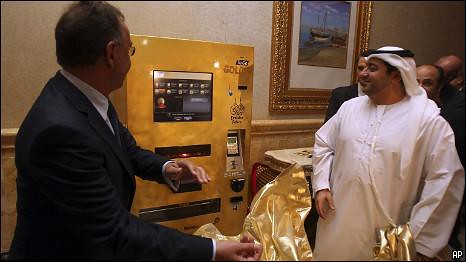
To read the complete article, see: 'Gold to Go': the ATM that dispenses gold bars (www.bbc.co.uk/worldservice/news/2010/05/100513_gold_atm_hs.shtml)
THE SOUTH AFRICAN 1898 POND SINGLE 9
Scott Schechter of Numismatic Guaranty Corporation forwarded a press release this week; he writes:
NGC graded one of the most celebrated world coins, the 1898 Single 9 Pond. This coin has a fascinating story, impeccable provenance, and is widely considered to be the most valuable coin ever struck on the African continent.
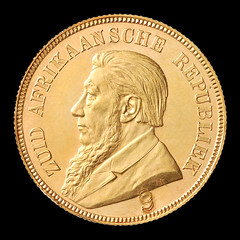
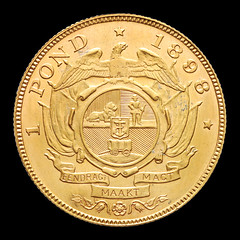
The details surrounding the creation of the Single 9 Pond form one of the most compelling stories in numismatics. The Single 9 was the first one pound gold coin produced during the Anglo-Boer War between South African and the British Empire in 1899. At that time, the government of the South African Republic sought legitimacy in the eyes of the international community. One of the best ways of doing this was to manufacture their own coins and currency.
Since they did not have a facility to produce dies for coinage in South Africa, the government contracted with a mint in Germany to create dies for 1899 coinage. En route from Germany to the Transvaal, the shipment of dies was intercepted and seized by the British.
Still wanting to press forward on making their own coins, the government's solution was to use dies from 1898 and punch a 9 on the obverse of the 1898-dated coins. Once the first coin was made, they realized that the 9 was too large – it intruded on the bust of President Kruger.
Only this first single coin was made with this punch, and all subsequent coins struck on this occasion were stamped with a pair of smaller nines. This second striking of coins is called the double 99 overstamp, and also comprises a rare and valuable South African coin; the single 9 stamp is unique.
The first coin, the Single 9, was immediately given to the United States Consul General, C.E. Macrum, as a means of confirming the South African Republic as an independent country with its own currency. Two pieces of correspondence, one written by the government assayer at the time, J. Perrin and the other by Macrum himself concerning this event still accompany the coin today. Macrum also had a small letter ‘M' engraved onto the coin on the truncation of Kruger's bust on the coin as a permanent marker of its provenance.
To read the complete press release, see: Legendary South African Coin Certified By NGC (www.ngccoin.com/news/viewarticle.aspx?IDArticle=1589&)
NGC LAUNCHES NEW METALLURGIC ANALYSIS SERVICE
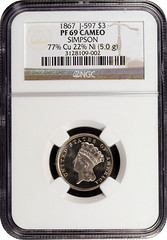 NGC is introducing a new service line to perform metal composition testing at the submitter's request. Metallurgic analysis is available for pattern, essay, trial and mint error coins, as well as tokens and medals. The cost of this service is $75 in addition to the NGC grading fee. Coins already certified and encapsulated by NGC can be re-submitted to NGC for metal testing and re-encapsulation for the flat fee of $75.
NGC is introducing a new service line to perform metal composition testing at the submitter's request. Metallurgic analysis is available for pattern, essay, trial and mint error coins, as well as tokens and medals. The cost of this service is $75 in addition to the NGC grading fee. Coins already certified and encapsulated by NGC can be re-submitted to NGC for metal testing and re-encapsulation for the flat fee of $75.
NGC performs composite surface scans of coins using x-ray fluorescence. While the tests are entirely non-invasive, they do allow NGC to peer beneath surface plating and any contaminants. Methods used by NGC are so gentle, however, that they can even be performed on coins that are still encapsulated. After testing, the results of analysis will appear on the NGC certification label along with the weight of the tested coin. NGC lists the three most abundant non-trace metals present on the coin's surface.
Metallurgic analysis is performed at NGC's facility by trained technicians. The turnaround time required for this service is approximately three-days in addition to the standard turnaround time for the accompanying service request. After certification is completed, tested coins are encapsulated in the Scratch-Resistant EdgeView® holder.
“NGC has used metal composition analysis for authentication purposes routinely, but we always believed that there was also a role for it to play in more precise attribution. Certainly this service will be a boon to collectors of pattern coins,” comments Rick Montgomery, NGC President.
NGC CEO, Steve Eichenbaum states that, “This service launch was really predicated on the availability of highly advanced and new technology. At NGC, we take innovation very seriously, and we continue to implement new services whenever we believe that they will meet the needs of collectors and numismatic professionals.”
Any questions about submission procedures or this new offering can be directed to NGC customer service at service@ngccoin.com or by phone toll-free at 1-800-NGC-COIN (642-2646).
To read the complete press release, see: NGC Launches New Metallurgic Analysis Service (www.ngccoin.com/news/viewarticle.aspx?IDArticle=1591&)
FEATURED WEB SITE: HISTORIC MAP WORKS
This week's Featured Web Site is Historic Map Works, a site which could be very useful to researchers. The company has online versions of a large number of old maps keyed to modern-day coordinates. Researchers can trace the development of a location over time as shown in successive maps. As towns grow and streets get lost or renamed, these features can be a great aid in pinpointing where Mints, businesses or homes once stood.
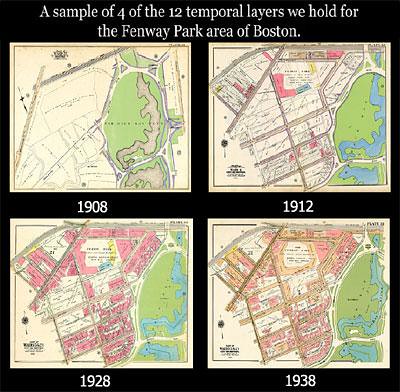
Based in Westbrook Maine, Historic Map Works, LLC is an Internet company formed to create a historic digital map database of North America and the world. Drawing on the largest physical collection of American property atlases of its type, it is our aim to be the single best online destination for map enthusiasts and researchers alike.
In addition to our own atlas collection, we incorporated our scans of the antiquarian world map collection from the Osher Map Library and Smith Center for Cartographic Education located at the University of Southern Maine. Combining these collections allows site visitors a vast amount of information spanning several centuries of cartographic information.
The vast majority of our database was created by scanning an original map at a high resolution by our team of highly skilled image technicians. After scanning, this team processes out the major imperfections while maintaining the look of an antiquarian map.
Maps are then uploaded and cataloged for viewing on our website. Our technicians geocode each map to a modern map to enable the search by address function. Linking the historic images in our database with geocode data allows visitors to search by modern day address or latitude and longitude coordinates. Other methods to view our maps include browsing by geographic location as well as searching our maps via keywords, town names, makers names, or simply by year.
Historic Map Works has two websites which host our maps. The first is www.historicmapworks.com which is aimed at individual subscribers and the second is Historic Map Works Library Edition which is distributed by ProQuest to public libraries and universities.
www.historicmapworks.com

